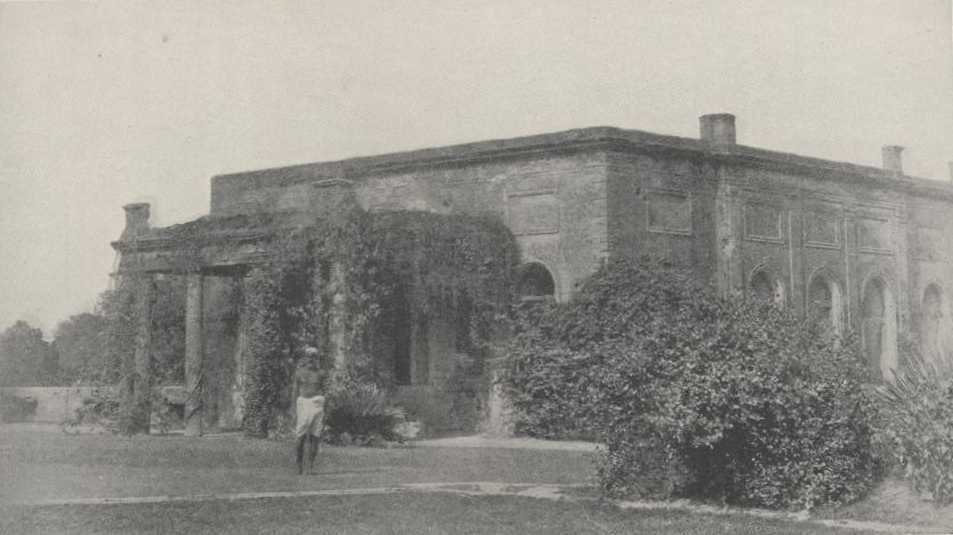"Lucknow was the epicenter of the highly evolved Indo-Islamic civilization, a unique post-Moghul center of fine art, poetry, high Urdu and gracious manners. This first disaster, the Sepoy Uprising, was primarily caused by the greed of the East India Company, which after many years snipping away at the edges of the Kingdom of Oudh decided to annex it all, including of course its capital Lucknow. The consequence of the British “victory” in the uprising was that what passed for India was to be run directly by the Crown rather than by the East India Company; the consequence for Lucknow was that by the time of Twain’s visit the pre-uprising glory had returned to the city but the power had not—and, as we know, glory without power soon becomes effete and pantomimic." (Strathcarron pg 150).
"The Great Imambara complex, centered around the late eighteenth-century mausoleum, is at the heart of the Indo-Islamic city and civilization that Twain saw when it was still alive and we now see as a needless wreck, a neglected monument to past Islamic colonial glories that seem at best like an irrelevance and at worst an embarrassment to modern Hindu India."
"But what a sight it must have been! The skyline of gilded domes and sculptured whitewashed cupolas and confident minarets were all on a grand, sweeping scale; one is reminded of Constantinople. Spread out between them were the formal gardens and watercourses, not unlike Versailles in scope and design. To the side were square lakes and wallowing palaces, not unlike Udaipur. It was a unique civilization born out of the heart of the disintegrating Moghul Empire moving east and absorbing Hindu influences as it did so, an attempt by the principalities to be more Moghul than the Moghuls. They called them the days of gold and silver: Islamic rule being the gold and Hindu influences being the silver, the best of all worlds."
Strathcarron (page 152)

Mark Twain’s next stop was the Chattar Manzil, the famous Umbrella Palace, so-called because of the brolly-shaped dome that sits on top of it. Twain lectured there, hosted by the United Services Club who used it as their headquarters. Udham Singh and his passengers were not detained there long; we got no nearer than the main gate and were turned away; the old palace is now the Central Drug Research Centre and out of bounds to anyone without the required swipe card.
Strathcarron (page 154)
"The photograph panel in the breakfast room showed that Twain’s main point of interest in Lucknow, the Residency—the scene of the heroic British resistance for five hot and horrible months to the Sepoy Uprising—was a tonga ride through open country from the Great Imambara. Not so now; after a nerve-racking hour-long walk through the obstacle course and race track of the new Lucknow we arrive at the Baillie Gate, the starting point then and now of the tour of the Residency. "
"The word “Residency” sounds like a single grand building with some matching grounds but actually it describes half a dozen grand buildings lying around a 65-acre park. It has been left exactly as it was at the end of the five-month siege, a series of shelled out or even razed buildings with only the size of the foundations to indicate their previous grandeur. It is today a perfectly tasteful monument to all those who died in the Sepoy Uprising, British and Indians alike—and, of course, many more loyal Indian natives died for the British cause than did British natives on this foreign soil. There was death and desperation in equal measure.
Strathcarron (page 153-4)
The Lucknow train station: In 1897 photographs show a rather undistinguished series of bungalow sheds spread over the width of twelve tracks. It looks at first sight like a staging post for cattle but of course it was for troops; mid-India Lucknow and its cantonment was a major marshaling point for the British Army. The trains were none too glamorous either, and the Patna Mathura Express 13238 rumbled along at a stately 35 miles per hour, stopping frequently, so the forty miles to Kanpur took over two hours.
Strathcarron (page 158)